The surrealists still see things as every one sees them, they complicate them in a different way but the vision is that of every one else, in short the complication is the complication of the twentieth century but the vision is that of the nineteenth century. Picasso only sees something else, another reality. Complications are always easy but another vision than that of all the world is very rare. That is why geniuses are rare, to complicate things in a new way that is easy, but to see the things in a new way that is really difficult, everything prevents one, habits, schools, daily life, reason, necessities of daily life, indolence, everything prevents one, in fact there are very few geniuses in the world.
Picasso saw something else, not another complication but another thing, he did not see things evolve as people saw them evolve in the nineteenth century, he saw things evolve as they did not evolve which was the twentieth century, in other words he was contemporary with the things and he saw these things, he did not see as all the others did, as all the world thought they saw, that is to say as they themselves saw them in the nineteenth century.
During this period there was another curious thing.
The color Picasso used was always important, so important that his periods were named after the color that he was using. To commence with the commencement.
The first influence of his first short visits to Paris, 1900, gave him the color of Toulouse Lautrec, the characteristic color of the painting of that period. That lasted a very short time and when he came back to Paris and returned to Spain the colors he used were naturally Spanish, the color blue, and the pictures of this period were always blue. When he was in France again and when French gaiety made him gay he painted in rose and that is called the rose period. There was really some blue in this period but the blue had rather a rose character than a blue character, so then it was really a rose period, that was followed by the beginning of the struggle for cubism, the African period which had some rose but which turned first to beige, later to brown and red as in my portrait and after that there was an intermediary period, before real cubism and that was a rather green period. It is less known but it is very very beautiful, landscapes and large still-lifes, also some figures. After that there were pale landscapes which little by little were followed by grey still-lifes. It was during this grey period that Picasso really for the first time showed himself to be a great colorist. There is an infinite variety of grey in these pictures and by the vitality of painting the greys really become color. After that as Picasso had then really become a colorist his periods were not named after their colors.
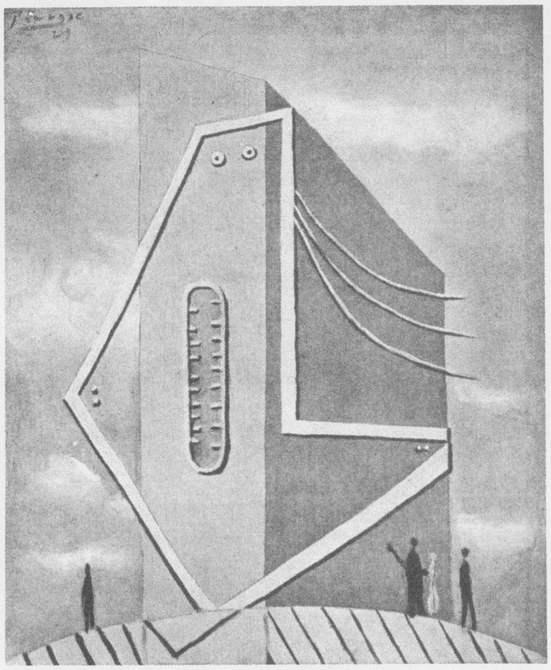
52 FEMME AU SOURIRE (1929)
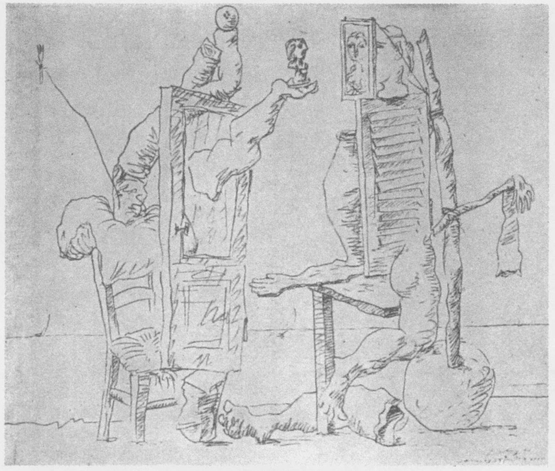
53 SURREALIST DRAWING (1933)
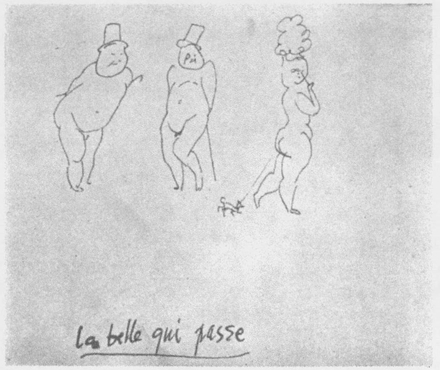
54 DRAWING (1905)
He commenced, this was 1914, to study colors, the nature of colors, he became interested in making pure colors but the color quality which he found when he painted in grey was a little lost, later when his second naturalistic period was over he commenced again to be enormously interested in color, he played with colors to oppose the colors to the drawings, Spaniard that he was it is natural that the colors should not help the drawing but should oppose themselves to it and it was about 1923 that he interested himself enormously in this. It was also during the calligraphic period, 1923, and later that this opposition of drawing and of color was the most interesting.
Little by little when the struggle not to be subjugated by the vision which was not his vision was going on, the colors commenced to be rather the ordinary colors that other painters used, colors that go with the drawing and finally between 1927 and 1935 Picasso had a tendency to console himself with Matisse’s conception of color, this was when he was most despairful that this commenced and this ended when he ceased to paint in 1935.
In fact he ceased to paint during two years and he neither painted nor drew.
It is extraordinary that one ceases to do what one has done all one’s life but that can happen.
It is always astonishing that Shakespeare never put his hand to his pen once he ceased to write and one knows other cases, things happen that destroy everything which forced the person to exist and the identity which was dependent upon the things that were done, does it still exist, yes or no.
Rather yes, a genius is a genius, even when he does not work.
So Picasso ceased to work.
It was very curious.
He commenced to write poems but this writing was never his writing. After all the egoism of a painter is not at all the egoism of a writer, there is nothing to say about it, it is not. No.
Two years of not working. In a way Picasso liked it, it was one responsibility the less, it is nice not having responsibilities, it is like the soldiers during a war, a war is terrible, they said, but during a war one has no responsibility, neither for death, nor for life. So these two years were like that for Picasso, he did not work, it was not for him to decide every moment what he saw, no, poetry for him was something to be made during rather bitter meditations, but agreably enough, in a café.
This was his life for two years, of course he who could write, write so well with drawings and with colors, knew very well that to write with words was, for him, not to write at all. Of course he understood that but he did not wish to allow himself to be awakened, there are moments in life when one is neither dead nor alive and for two years Picasso was neither dead nor alive, it was not an agreeable period for him, but a period of rest, he, who all his life needed to empty himself and to empty himself, during two years he did not empty himself, that is to say not actively, actually he really emptied himself completely, emptied himself of many things and above all of being subjugated by a vision which was not his own vision.
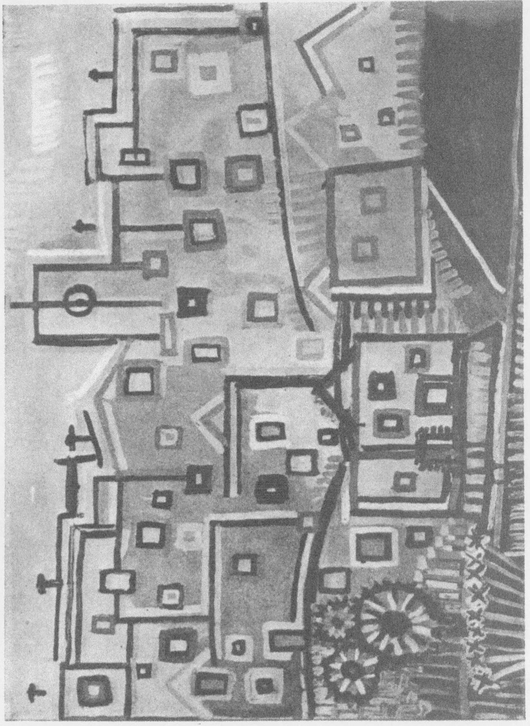
55 LANDSCAPE (1937)

56 LA FEMME QUI PLEURE (1938)
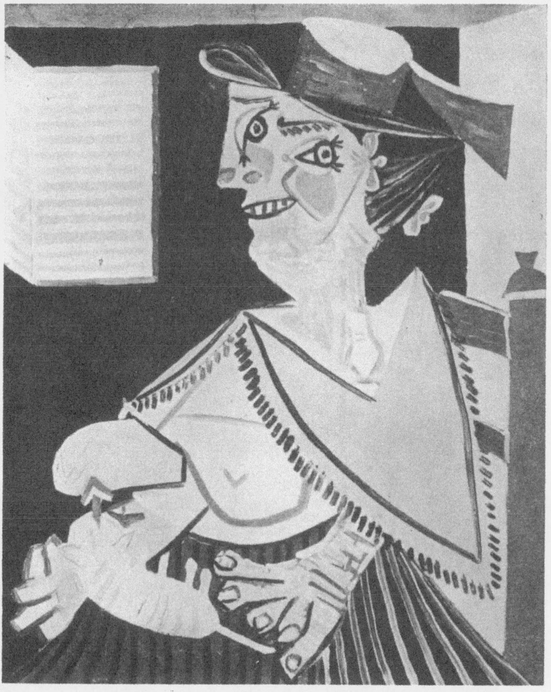
57 LA FEMME AU FICHU (1938)

58 WOMAN WITH LONG HAIR (1938)
As I have said Picasso knows, really knows the faces, the heads, the bodies of human beings, he knows them as they have existed since the existence of the human race, the soul of people does not interest him, why interest one’s self in the souls of people when the face, the head, the body can tell everything, why use words when one can express everything by drawings and colors. During this last period, from 1927 to 1935, the souls of people commenced to dominate him and his vision, a vision which was as old as the creation of people, lost itself in interpretation. He who could see did not need interpretation and in these years, 1927 to 1935, for the first time, the interpretations destroyed his own vision so that he made forms not seen but conceived. All this is difficult to put into words but the distinction is plain and clear, it is why he stopped working. The only way to purge himself of a vision which was not his was to cease to express it, so that as it was impossible for him to do nothing he made poetry but of course it was his way of falling asleep during the operation of detaching himself from the souls of things which were not his concern.
To see people as they have existed since they were created is not strange, it is direct, and Picasso’s vision, his own vision, is a direct vision.
Finally war broke out in Spain.
First the revolution and then war.
It was not the events themselves that were happening in Spain which awoke Picasso but the fact that they were happening in Spain, he had lost Spain and here was Spain not lost, she existed, the existence of Spain awakened Picasso, he too existed, everything that had been imposed upon him no longer existed, he and Spain, both of them existed, of course they existed, they exist, they are alive, Picasso commenced to work, he commenced to speak as he has spoken all his life, speaking with drawings and color, speaking with writing, the writing of Picasso.
All his life he has only spoken like that, he has written like that, and he has been eloquent.
So in 1937 he commenced to be himself again.
He painted a large picture about Spain and it was written in a calligraphy continuously developed and which was the continuation of the great advancement made by him in 1922, now he was in complete effervescence, and at the same time he found his color. The color of the pictures he paints now in 1937 are bright colors, light colors but which have the qualities of the colors which until now only existed in his greys, the colors can oppose the drawing, they can go together with the drawing, they can do what they want, it is not that they can agree or not with the drawing that they are there, they are there only to exist, certainly Picasso has now found his color, his real color in 1937.
Now this is the end of this story, not the end of his story, but the end of this story of his story.
EPILOGUE
To-day the pictures of Picasso have come back to me from the exhibition at the Petit Palais and once more they are on my walls, I can not say that during their absence I forgot their splendor but they are more splendid than that. The twentieth century is more splendid than the nineteenth century, certainly it is much more splendid. The twentieth century has much less reasonableness in its existence than the nineteenth century but reasonableness does not make for splendor. The seventeenth century had less reason in its existence than the sixteenth century and in consequence it has more splendor. So the twentieth century is that, it is a time when everything cracks, where everything is destroyed, everything isolates itself, it is a more splendid thing than a period where everything follows itself. So then the twentieth century is a splendid period, not a reasonable one in the scientific sense, but splendid. The phenomena of nature are more splendid than the daily events of nature, certainly, so then the twentieth century is splendid.

59 PICASSO
From a Photograph by Cecil Beaton
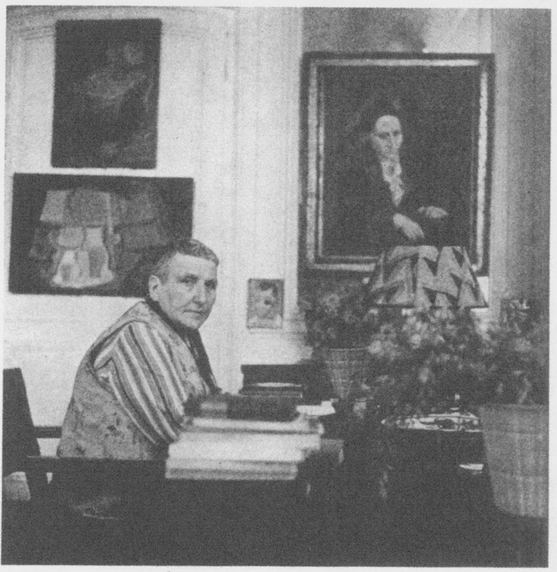
60 GERTRUDE STEIN
From a Photograph by Cecil Beaton
It was natural that it was a Spaniard who understood that a thing without progress is more splendid than a thing which progresses.
1 comment